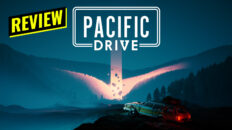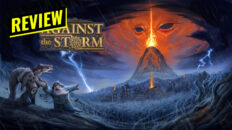Developer: Something We Made
Publisher: Something We Made
Reviewed on: Switch
Purchased.
TOEM’s vibrant, charming world just begs you to check every nook and cranny to discover all the secrets they hide. It’s intuitive, yet simple, camera controls let you peer into every one of those nooks and crannies to help solve everyone’s problems. It’s a fantastic adventure game that truly captures the fun of going on a journey armed with only your camera, and a faraway destination to reach. It also does a great job of teaching basic aspects of photography while not being technically overwhelming.
TOEM is all about your journey to visit a famous mountain that your mother also visited as a young woman. She gives you her camera, goes over a few basic things like zooming and taking selfies, then sends you on your way. Each area in the game has a variety of characters and events that you must use your camera to “solve”. Most of these are basic, like take a picture of a certain type of animal, but others require you to be in a certain spot to get the right angle. There are even a few that don’t require the camera at all, like walking around with a hotdog hat on to promote someone’s new food truck. TOEM strikes a great balance between challenge, accessibility, and variety. Completing these quests is also how you gain access to the next level, but thankfully you don’t need to complete every single one.
The most unique aspect of TOEM is the art style and aesthetic. The primary perspective is free-moving isometric camera angle that can also be zoomed in and out, kind of like a drone shot. This gives you a great overview of the world, and the amazing hand-drawn 3D art style. Everything is in grey scale, but the art is so detailed and expressive that I often forgot that everything was just shades of grey. Characters and some objects are also in 2D, making them stand out in the 3D space, much like the Paper Mario games. The perspective completely changes, however, when you take a picture. It zooms down into first person allowing you a 360 degree, up close view of everything around you. It also lets you see things that the isometric camera may not have given you an angle on, like under bridges or around a corner. It’s really a fantastic way to unscored how important different perspectives are in photography, and the game’s controls make it smooth and easy to manipulate.
I also need to shout out the great soundtrack because the game makes a big deal about giving credit to every song in the game. When a new song plays the track title and artist will pop up at the bottom of the screen. You’ll often unlock thematically appropriate songs for completing some quests. All these songs can be accessed and played back in your inventory menu as well. The song selection fits perfectly with the mood and aesthetic of the game and what’s going on in each level. It really adds a nice soundtrack to your chill, but exciting journey.
By focusing on one thing and perfecting it, TOEM manages to capture the spirit of going on a road trip. While every trip has a destination, it’s really about the friends and memories you make along the way. You may end up feeling a little underwhelmed when you finally reach your destination, but that’s intentional because all journeys must end eventually. Luckily you have a huge photo album brimming with smiling faces, funny creatures, and amazing sites that you can always look back on fondly. TOEM really captures what I love about being a photographer, while never being too on the nose about what it’s doing.







